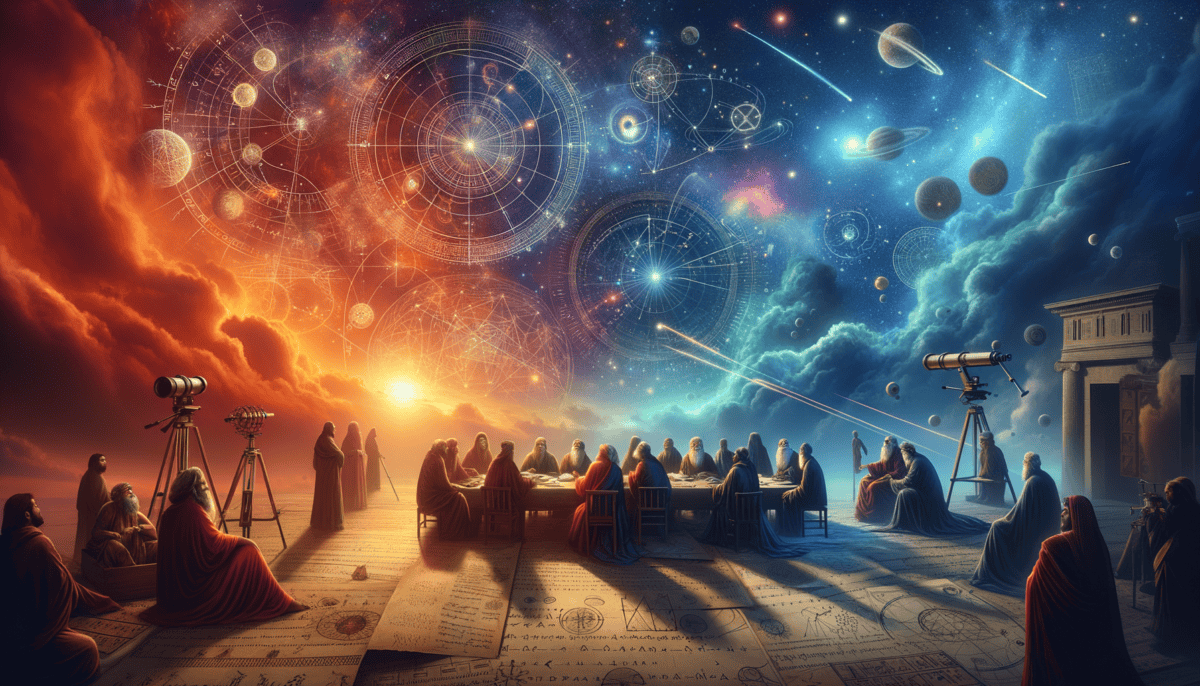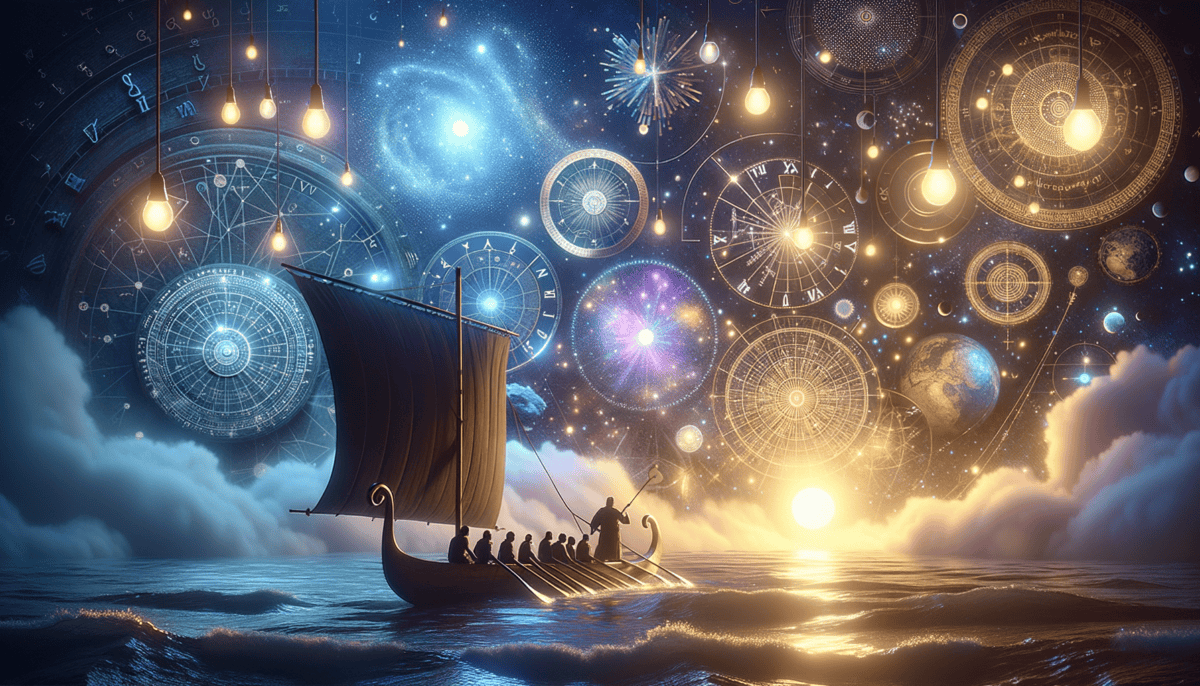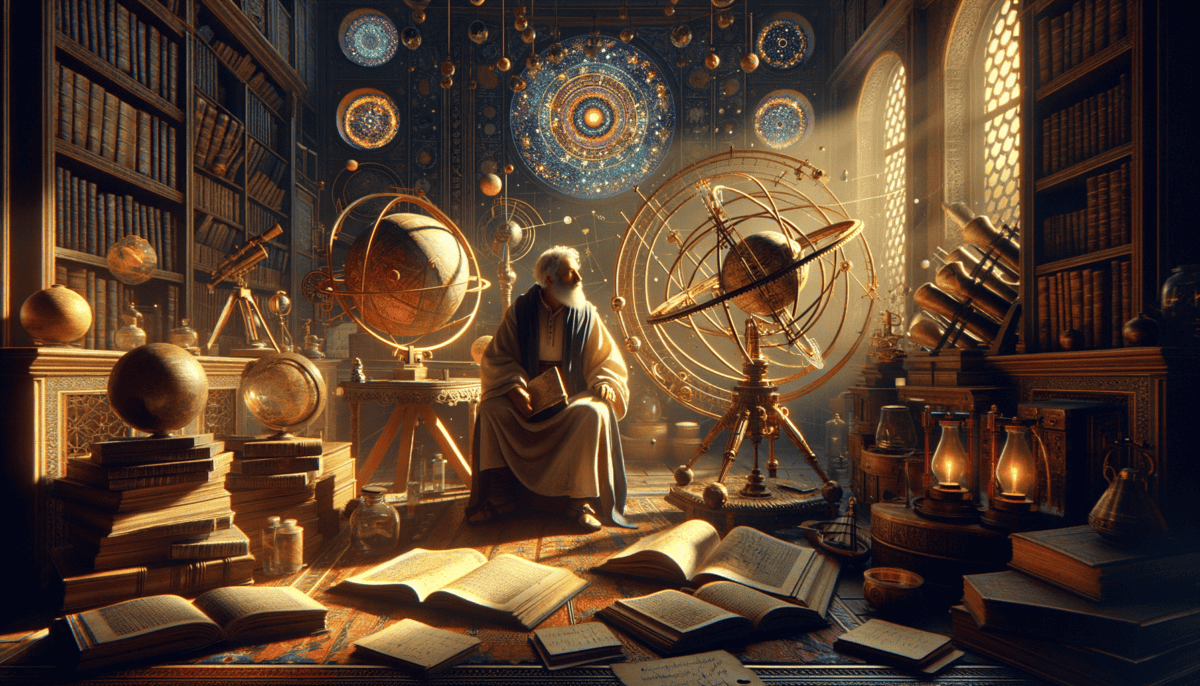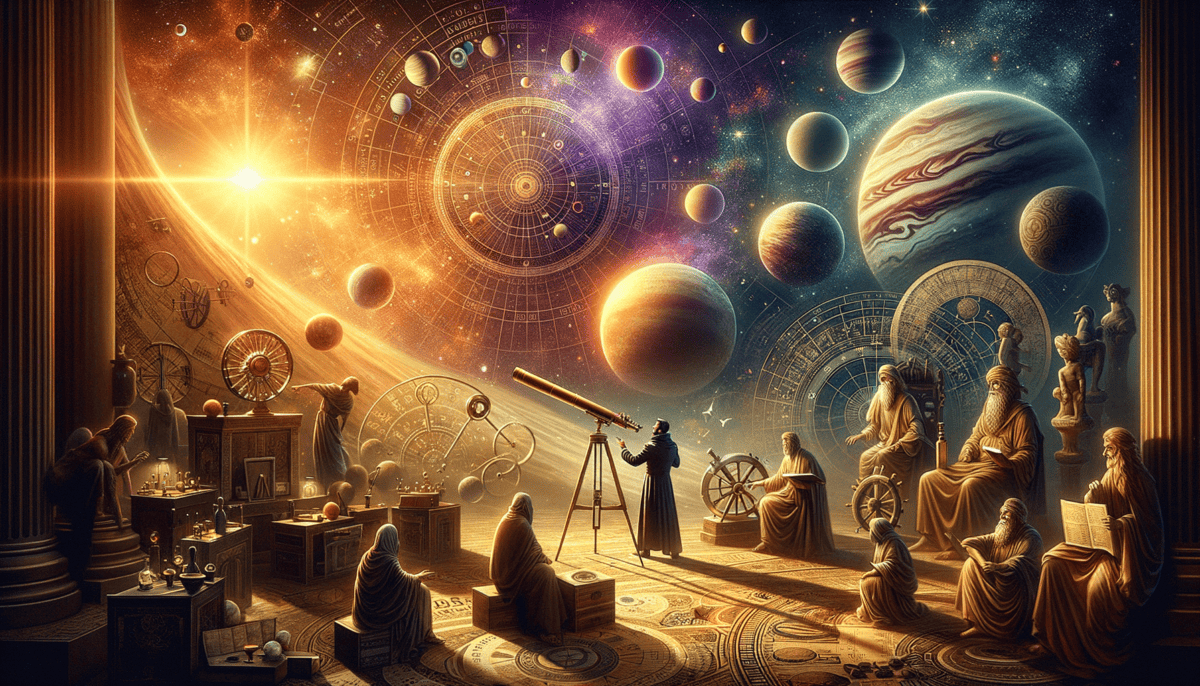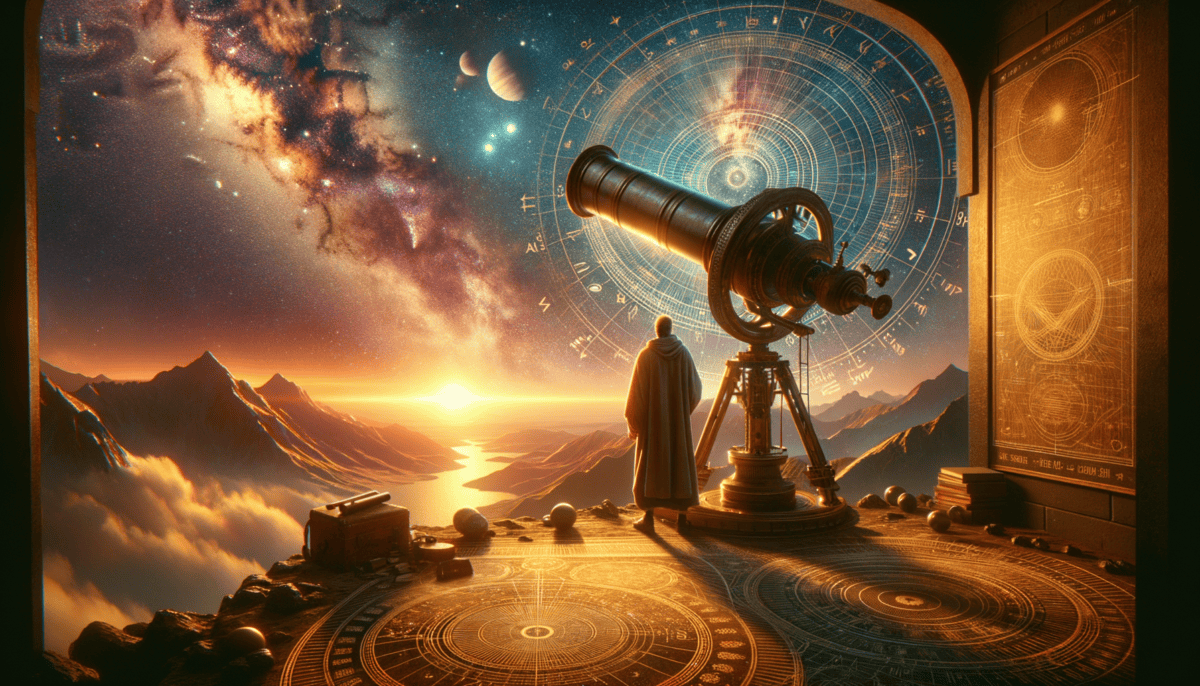The Stars Above Us: A Journey Through the History of Astronomy
Kiyana peered up at the twinkling stars, her eyes wide with wonder. The warm desert breeze of ancient Babylon swept across her face as she sat beside her grandfather, Adad, on their favorite hilltop. The year was 700 BCE, and the night sky was ablaze with countless points of light.
"Grandfather, why do you watch the stars every night?" Kiyana asked, tugging at Adad's royal blue robes. As the head astronomer of the temple, he spent countless hours studying the heavens.
Adad smiled warmly. "The stars tell us stories, little one. They help us know when to plant crops, when to celebrate festivals, and they guide travelers across vast distances."
He pulled out a clay tablet and pointed to the careful markings etched into its surface. "Look here – we've been tracking the movement of these five special stars for generations."
"But they don't look like regular stars," Kiyana observed, squinting at the bright points her grandfather indicated.
"That's because they're different – we call them 'wandering stars.' They move across the sky in their own special paths." Adad traced their patterns in the air with his finger. These wandering stars would later be known as planets, but for now, they were celestial mysteries that demanded attention.
In the temple gardens below, other astronomers gathered with their own clay tablets, carefully noting the positions of celestial bodies. Their recordings would later become the foundation of astronomical knowledge, passed down through generations.
"Can you teach me how to read the sky?" Kiyana asked eagerly.
Adad's eyes sparkled. "Of course! First, let's learn about the most important patterns we see up there. We call them constellations."
The old astronomer pointed to a group of stars. "See those stars that make a shape like a shepherd's crook? That's what we call 'The Shepherd of Anu.' It appears every year when the weather turns cold."
Kiyana leaned closer to her grandfather as he shared the key observations they had made:
- The moon changes its shape over 28 days
- Some stars only appear in certain seasons
- The sun's path changes throughout the year
- Five special "wandering stars" move differently from the others
- Eclipses happen in regular patterns
As night deepened, more astronomers joined them on the hilltop. They brought fresh clay tablets and carefully sharpened reeds for writing. Each night, they added to their growing collection of star maps and predictions.
"Look there!" Kiyana suddenly exclaimed, pointing at a bright streak across the sky. "A falling star!"
"Ah, we record those too," Adad explained. "Everything in the heavens has meaning, little one. That's why we watch so carefully."
The little girl yawned, fighting to keep her eyes open. The night was getting late, but she didn't want to leave this magical moment with her grandfather and the stars.
"Tomorrow night, I'll teach you how to use the water clock to measure time by the stars," Adad promised, wrapping his warm cloak around her shoulders.
As they made their way back down the hill, Kiyana took one last look at the glittering sky above. She knew that long after she and her grandfather were gone, others would continue watching these same stars, learning their secrets and passing that knowledge to future generations.
The clay tablets they created that night would survive for thousands of years, teaching modern astronomers about how our ancestors first began to understand the cosmic dance above their heads.
The Dance of Ideas: Ancient Greece’s Sky Watchers
The warm Mediterranean sun cast long shadows across the marble steps of the Academy in Athens. Young Theron sat eagerly at the feet of his teacher, the renowned philosopher Aristarkos, as other students gathered around. The year was 350 BCE, and new ideas about the cosmos were beginning to challenge old beliefs.
“But Master Aristarkos,” Theron spoke up, his curiosity burning brighter than the afternoon sun, “if the Earth is round, why don’t we fall off?”
The ancient Greeks were among the first to suggest that Earth was a sphere, not flat!
Aristarkos smiled, picking up an apple from his basket. “Watch this, young one.” He held the apple up for all to see. “Everything is pulled toward the center of the Earth, just like how all parts of this apple hold together in its round shape.”
The students whispered among themselves, some nodding in understanding while others looked confused. The teacher continued his lesson, explaining the main ideas Greek thinkers had about space:
- Earth is at the center of everything
- The sun, moon, and stars move around us
- The sky is made of crystal spheres
- Stars are fixed in place
- Planets follow special paths
“But not everyone agrees with these ideas,” Aristarkos said with a twinkle in his eye. “Some thinkers, like Aristarchus of Samos, believe the Sun might be at the center instead!”
Theron’s eyes widened. “Is that possible?”
“In science, we must always ask questions,” Aristarkos replied. He drew circles in the sand with his staff, showing how the planets might move. “Look here – see how this could explain why planets sometimes appear to move backward in the sky?”
“But the gods placed Earth at the center!” one student protested.
“Perhaps,” Aristarkos responded gently, “but our job as philosophers is to observe and think carefully about what we see.” ⭐
Later that evening, Theron joined his teacher at the observatory platform. They used a simple tool called a gnomon – a tall stick that cast shadows – to track the sun’s movement.
“Remember,” Aristarkos said as they measured the shadow’s length, “some of our greatest thinkers disagree about how the heavens work. Aristotle believes one thing, while Ptolemy suggests another.”
As the first stars appeared in the darkening sky, Theron helped record their positions on a papyrus scroll. Together, they observed how some stars made perfect circles around a point in the northern sky.
“Master,” Theron asked thoughtfully, “what if all our ideas about the cosmos are wrong?”
Aristarkos patted his shoulder. “That’s the most important question of all. A true seeker of knowledge must always be ready to change their mind when new evidence appears.”
The night grew deeper, and more students joined them on the observation platform. They used bronze mirrors to reflect starlight, making measurements and discussing theories about the universe’s structure.
In his notebook, Theron carefully drew the patterns they observed, adding his own thoughts and questions. Little did he know that these Greek ideas about astronomy would influence scientific thinking for over a thousand years.
As an owl hooted in the distance, Aristarkos gathered his students close. “Remember, young philosophers – the universe is full of mysteries waiting to be solved. Never stop questioning what you think you know.”
The stars continued their eternal dance overhead, inspiring new generations of thinkers to look up and wonder about their place in the vast cosmic order.
Voyagers of the Star Sea
The gentle waves lapped against the double-hulled canoe as Kekoa stood at the stern, his eyes fixed on the evening sky. The young navigator-in-training had spent countless nights learning the star paths from his grandmother, Master Navigator Lani.
Lani pointed to a bright star appearing on the horizon. “What do you see, my grandson?”
Polynesian navigators could find their way across thousands of miles of open ocean using only the stars, waves, and clouds as their guide!
“That’s Hōkūle’a,” Kekoa answered confidently. “The Star of Gladness. It rises in the east and shows us the way to Tahiti.” ♂️
The salty breeze carried the scent of the ocean as other young navigators gathered around. Tonight was special – they would learn the star compass, a mental map divided into houses where different stars rise and set.
Lani drew a circle in the sand on the beach, marking the cardinal directions. “The stars are our ancestors’ gift,” she explained. “They left us a map in the sky.”
“But Grandmother,” asked Kekoa, “what if clouds hide the stars?”
“Then we read the waves,” Lani smiled. “The ocean tells stories too.”
She taught them the essential star positions they needed to know:
| Star Name | Direction | Season |
|---|---|---|
| Hōkūle’a | South | Summer |
| Māui’s Fish Hook | East | Winter |
| The Seven Little Eyes | North | Spring |
As night deepened, Lani shared stories of great voyages. “Our ancestors crossed vast oceans in canoes like ours,” she said, patting the wooden hull. “They found new islands using these same stars we see tonight.”
The next morning, Kekoa helped prepare the canoe for a training voyage. They would sail beyond sight of land, using only traditional navigation methods to find their way home.
“Remember,” Lani instructed as they pushed off from shore, “a navigator must know the star paths like they know their own home.” ⭐
Throughout the day, Kekoa practiced reading the waves and clouds. When night fell, the stars emerged like old friends. He recognized the patterns Lani had taught him, each constellation telling him something about their position.
Different stars appear at different heights in the sky depending on how far north or south you travel!
“Look,” Lani pointed to where two wave patterns crossed. “The island lies where the waves meet beneath tomorrow’s rising sun.”
Kekoa felt proud as he steered the canoe through the darkness, guided by the same stars that had led his ancestors to new homes across the vast Pacific Ocean.
Dawn broke over the horizon, painting the sky in brilliant colors. Just as Lani had predicted, their home island appeared exactly where the wave patterns intersected.
“You’re learning well,” Lani said proudly. “Soon you’ll be ready to guide your own voyages, carrying our traditions forward to the next generation.”
As they sailed into the lagoon, Kekoa knew this was just the beginning of his journey as a star navigator, following in the wake of countless generations before him.
A New View of Our World
The candle flickered in Nicholas Copernicus’s study as he carefully drew circles on his parchment. The year was 1514, and the young astronomer couldn’t sleep. Something about the way people thought the universe worked just didn’t make sense to him.
For thousands of years, everyone believed Earth was the center of everything. But Copernicus had a different idea!
“What if,” he whispered to himself, picking up another sheet of calculations, “the Sun is actually the center, and Earth moves around it?”
His cat, Stella, purred softly as she watched him work. Outside his window in Frombork, Poland, the stars twinkled brightly. They seemed to be encouraging him to keep thinking differently. ✨
“But Master Copernicus,” his student Johann would later ask, “won’t people be angry if you say Earth isn’t the center?”
“Sometimes,” Nicholas replied gently, “we must follow the truth, even when it’s scary.”
| Old Idea | New Idea |
|---|---|
| Earth at center | Sun at center |
| Sun moves around Earth | Earth moves around Sun |
| Stars fixed in place | Earth spins to make stars seem to move |
Nicholas spent many nights watching the planets through his window. He noticed that their movements made more sense if they were all going around the Sun. It was like solving a giant puzzle in the sky!
Years passed as Nicholas carefully wrote down his ideas. He knew they were different from what everyone believed. He worked quietly in his tower, measuring and calculating.
“Look here,” he showed Johann one evening, pointing to his drawings. “See how much simpler it is when we put the Sun in the middle? All the planet paths make perfect circles!”
Copernicus’s book explaining his new ideas wasn’t published until the very end of his life. He was worried about what people would think!
Finally, when Nicholas was very old, his friends convinced him to share his work with the world. They knew his ideas were too important to keep secret.
“What if I’m wrong?” he worried, holding the finished book in his hands.
“The stars themselves have shown you’re right,” Johann reassured him. “Future astronomers will thank you for your courage.” ⭐
On his last day, Nicholas held his newly printed book. He had changed how we see our place in space forever. The Earth wasn’t the center of everything – it was part of a beautiful dance around the Sun.
As night fell, Stella curled up next to him, purring softly. Through his window, the stars continued their eternal dance, now with a new story to tell.
Through Galileo’s Eyes
The wooden telescope felt heavy in Galileo’s hands as he climbed the stairs to his rooftop observatory in Padua, Italy. It was 1609, and he had just made something amazing – a telescope that could make far things look close!
Galileo didn’t invent the telescope, but he made it much better. His telescope could make things look 20 times bigger!
“Virginia, come see!” he called to his daughter. “I want to show you something wonderful.” The young girl hurried up the stairs, her eyes bright with curiosity.
“What are we looking at tonight, Father?” Virginia asked excitedly.
“Tonight, my dear, we’re going to look at Jupiter,” Galileo smiled. “I’ve noticed something very special about it.” ⭐
Through his telescope, Galileo and Virginia watched as tiny dots of light danced around Jupiter. Night after night, they moved in different patterns.
| What People Thought | What Galileo Saw |
|---|---|
| Everything circles Earth | Moons circle Jupiter |
| Moon is perfectly smooth | Moon has mountains and craters |
| Venus never changes | Venus has phases like our Moon |
Galileo made careful drawings of everything he saw. When he looked at the Moon, he discovered it wasn’t smooth at all – it had mountains and valleys, just like Earth!
But not everyone was happy about Galileo’s discoveries. Some people got very angry when he said Copernicus was right about the Earth moving around the Sun.
“Look through the telescope,” Galileo would say, offering his instrument to doubters. “See for yourself!”
Some people refused to even look through Galileo’s telescope. They didn’t want to see anything that might change their minds!
Even when they tried to stop him from teaching his ideas, Galileo kept watching the stars. He knew what he saw was true. Virginia helped him write down his observations when his eyes grew tired.
“Why do they fear the truth so much?” Virginia asked one night.
“Sometimes new ideas can be scary,” Galileo explained. “But the universe is too beautiful to keep hidden.”
Years later, Galileo had to promise to stop teaching about Earth moving around the Sun. But he never stopped believing what his telescope had shown him.
As he sat in his garden one evening, watching Venus shine brightly in the sky, he smiled. He knew that someday, everyone would understand what he had seen through his telescope. The truth about our place in space would shine as bright as the stars themselves. ✨
A Universe of Possibilities
The stars twinkled brightly over Mount Wilson Observatory as Edwin Hubble walked into his dome on a crisp October evening in 1923. His heart raced with excitement – he was about to change how we see our place in space!
“Milton, come look at this photograph!” Hubble called to his assistant. “I think we’ve found something incredible.”
“What is it, Edwin?” Milton hurried over, adjusting his glasses.
“See these fuzzy patches? They’re not just clouds of gas – they’re whole other galaxies, just like our Milky Way!” ⭐
Before Hubble’s discovery, people thought our galaxy was the whole universe. But he proved the universe is much, much bigger!
Using the giant 100-inch telescope, Hubble took pictures of what people used to call “spiral nebulae.” Night after night, he studied these mysterious objects in the sky.
| What We Used to Think | What Hubble Discovered |
|---|---|
| One galaxy exists | Billions of galaxies exist |
| Universe is still | Universe is growing |
But Hubble’s biggest surprise was yet to come! When he measured the light from distant galaxies, he noticed something amazing – they were all moving away from us. The universe was growing bigger!
Years later, people built a special telescope and named it after Hubble. They sent it high above Earth’s clouds, where it could take clear pictures of space.
“What do you think Galileo would say if he could see these pictures?” a young astronomer asked, looking at the colorful images from the Hubble Space Telescope.
“I think he’d be overjoyed,” another replied. “Just look at how far we’ve come!”
Today, we know our universe is full of billions of galaxies, each with billions of stars. We’ve found planets around other stars and learned that space is more amazing than anyone imagined!
From the first stargazers in Babylon to Hubble’s amazing discoveries, humans have always looked up at the night sky with wonder. Every new discovery shows us how much more there is to learn.
As you look up at the stars tonight, remember – you’re part of this great story too. What mysteries of space will you help solve? The universe is waiting for the next curious mind to unlock its secrets! ✨


